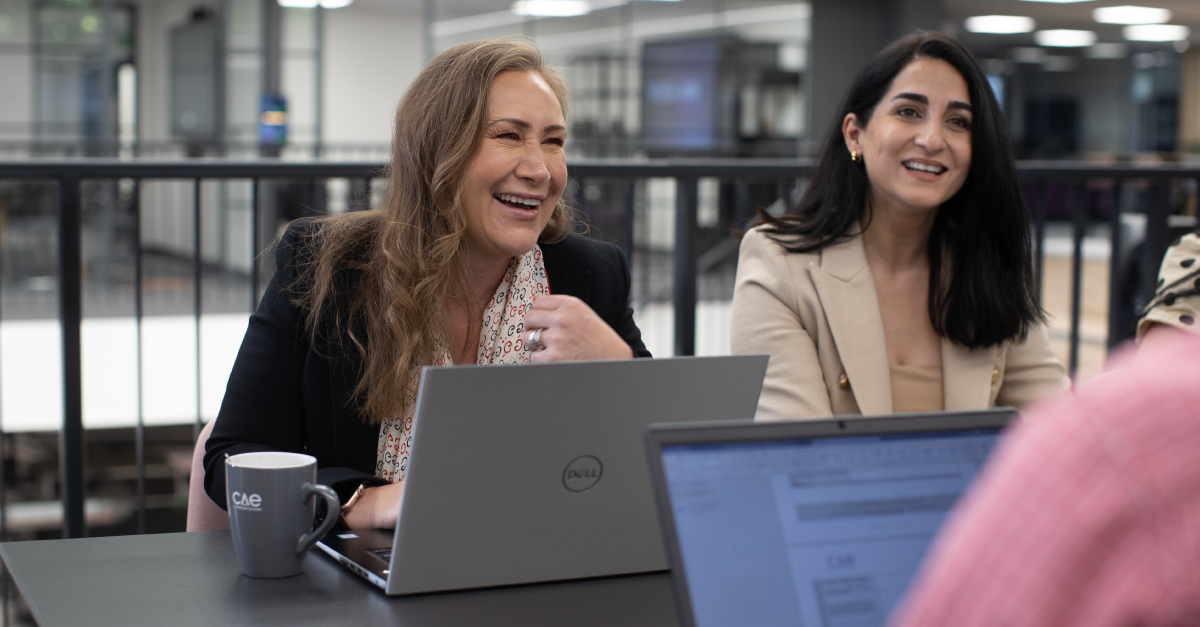New, innovative technologies create opportunities for us to rethink the way we work and redefine where we work. And the need for always-on communication and anytime, anywhere access to data and insights is causing businesses to rethink working practices and break down traditional barriers.
About the author
Louise Mahrra Head of Marketing for CAE.
 Having worked in a variety of industries through her career, from a world-leading technology brand, to Europe’s number 1 protein ingredients manufacturer, Louise is always focused on achieving high impact and value through thought leadership. Louise describes herself as first and foremost a storyteller who connects with her audience and creates meaningful content that excites, inspires and educates.
Having worked in a variety of industries through her career, from a world-leading technology brand, to Europe’s number 1 protein ingredients manufacturer, Louise is always focused on achieving high impact and value through thought leadership. Louise describes herself as first and foremost a storyteller who connects with her audience and creates meaningful content that excites, inspires and educates.
We no longer live in a bubble of 9-to-5, where you leave the office – and your device – behind at the end of the working day! In fact, there is no end of the working day for today’s modern workforce.
Technology is changing both the way we actually work, and the way we think about work.
And with the next generation entering the workplace with a wholly different set of expectations, businesses are having to navigate these. This new workforce is tech-savvy, and demands flexibility in the way it works.
The acceptance today of hybrid and home working practices is causing a dramatic shift in business communication and collaboration. And in today’s challenging and highly competitive recruitment landscape, it is more critical than ever for businesses to attract and retain.
Tearing up the rule book
When it comes to technology, the modern workplace is tearing up the rule book and demanding different expectations.
Yesteryear’s desktop set-up – allocated desk, landline handset, desktop computer – is not the dominant model anymore. When was the last time you walked into any office, anywhere and saw a desk phone!
![]() The modern workplace defines the model in the mobile-cloud era.
The modern workplace defines the model in the mobile-cloud era.
People need secure access to their work wherever and whenever they need, which has resulted in the boundaries and requirements of a set place of work blurring.
In a world that is constantly in motion, immediate and responsive, having the ability to collaborate face-to-face on a document with colleagues – even in different locations or time zones – is almost expected as standard.
Real-time interactions, quick decision making, and on-the-move technology capabilities are all driving the rapidly transforming workplace.
Putting people first in technology transformation
People are central to this change. They’re the ones demanding anytime, anywhere, any device working practices, and technology needs to respond in kind.
IT must provide the tools they need to be secure, productive, and collaborative in a consistent manner – no matter where they are or how they choose to connect.
And while it’s easy to imagine the office of the future as a disparate set of individuals on screens, this idea misses the importance of the human element. People enjoy being part of a community and crave human interaction.
Not to mention that companies are realising the power of the spark – those lightbulb moments which arise in a chance conversation or meeting, often between people from different areas of the business.
As a result, offices are being designed not simply to support collaboration but to actively encourage collision.

Large, attractive spaces, indoor and out, help create those chance encounters and unplanned interactions which spark innovation.
With face-to-face interactions as the most important activity, the office can evolve from just another building into a collaboration hub. A place where people choose to spend time.
Innovation and adaptability drive constant change
Today’s businesses face growing threats of competition and market disruption.
In the past, disruption typically came from large, global rivals, and much of the disruption was built on the![]() platform of the smartphone and the cloud access it enabled.
platform of the smartphone and the cloud access it enabled.
Today, disruption can come from anywhere.
The past ten years has seen an influx of crowd-funded, start-ups that are challenging the status quo. These could become the public giants of tomorrow.
Most people realise there’s a need to innovate and adapt. But to do this successfully, organisations depend on talented people identifying and responding to threats.
If office practices are so static that the talent doesn’t come, then it’s no wonder problems are compounded.
As we look ahead to the next generation of growth, it’s obvious that things are changing.
What businesses need to be successful isn’t the same as what it used to be.
It’s more than just a fresh use for an emerging technology. We’re now seeing other factors play into companies’ long-term success: the importance of embracing diversity, an inclusive culture that celebrates belonging, empowering people to choose when, where and how they work; all underpinned by listening to end-users and customers alike.
Flexibility is key for today’s workforce – in fact, surveys suggest nearly half prioritise workplace flexibility over pay. Team cohesion, appreciation, and global opportunities are also coming out top. Today’s workers are comfortable with change and will move on if they feel undervalued or overworked.
With strong ideas about when, how and where they work, it’s clear that organisations that don’t prioritise flexibility and mobility risk losing out on top tier talent.
Welcome to the office of the future
The office of the future needs to mix digital and physical space, encourage sociability and communication, and promote flexible and agile working practices.
The rule of the physical office space is being redefined as businesses move into the digital workplace, and the traditional rule book is being torn up and re-written.
And it is technology that underpins the all-important agility and collaboration.
![]() Digital cloud-based technology allows colleagues to communicate, attend virtual meetings, and access company data without stepping foot in an office. It helps businesses capitalise on new and changing mobile workstyles to accelerate modern working and drive better business results.
Digital cloud-based technology allows colleagues to communicate, attend virtual meetings, and access company data without stepping foot in an office. It helps businesses capitalise on new and changing mobile workstyles to accelerate modern working and drive better business results.
What’s more, the technology is readily available!
It’s simple to use and secure for the business – the challenge is more around creating a cultural environment for a joined-up approach.
Successful implementation of any technology is less about the technology itself and more about the way of doing things.
Businesses need to give equal thought to three key components: people, process, and technology.
Organisations must understand the environment in which they operate and how new technologies should fit within that environment.
But just as important is employee consideration: how will they react? And how can they be helped identify the value for them?
MORE GOOD DAYS
CAE is a trusted technology partner who makes people’s lives more straightforward, productive, fulfilling and enjoyable by providing the intuitive IT services they need every day. We specialise in providing technology that’s on point by taking proven vendor solutions, combining them and tailoring them on request.
We help businesses transform through technology, and provide value-added support to deliver more good days. We do this by listening to your needs and understanding them, so you achieve the outcomes you need.
Challenge us to build your roadmap to an advanced collaborative working environment. By using digital workplace technology, you can increase employee satisfaction, retention, productivity, collaboration, and security, while delivering a consistent experience.

